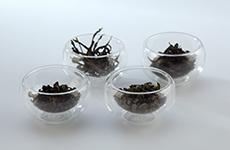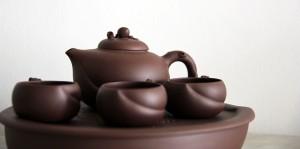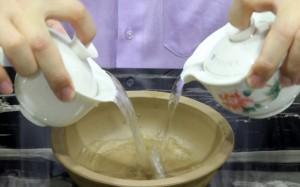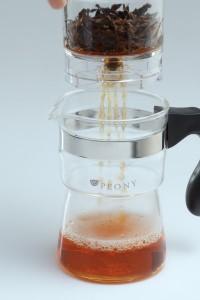In terms of brewing tea, perhaps there is no category of tea that is more demanding than oolong tea. Indeed the relationship between oolong tea and gongfu tea is intricately woven, one that you can read about in this article.
As I am wont to proclaim given half a chance- “gongfu tea is not ceremonial, it’s about effort”. As written in the article referenced above- the word gongfu (工夫) instead of gongfu (功夫) means effort, time and leisure as opposed to skill.
Though skill is important, it’s primarily about making effort to do the extra steps, the little things. Re-steeping smaller vessels often, drinking from smaller cups often and not throwing some leaves in a huge pot and guzzling from it.
Going out on a limb, I would say that if you’re serious about oolong tea, you should make gongfu brewing your method of choice. Though there are occasions when casual brewing may be the only option, wherever and whenever possible, gongfu brewing is the way to go if you don’t wish to waste your tea leaves.
There are 3 main elements in taming the black dragon (oolong):
i) Knowing thy tea
ii) Equip thyself
iii) Knowing thyself
Knowing Thy Tea
Not all teas are created equal. That much is certain. Oolong tea is the most diverse category of tea. For example, Wenshan Baozhong is lightly oxidized and has a refreshing quality reminiscent of green tea while Dongfang Meiren has a lingering fragrance and fruitiness that brings to mind well-made black teas.
In brief- oolong teas are often subdivided into the following 4 categories (you can read about it here)

ii) Minbei Oolong- Wuyi Yancha and JianOu/JianYang Shuixian
iii) Minnan Oolong- Tieguanyin and its brethren, Yongchun Foshou etc
iv) Taiwanese Oolong- High Mountain teas, Dong Ding, Baozhong
In general, teas within the same sub-category are similar in characteristics and production styles. This is not always the case, for example within the category of Minnan Oolong there is also Zhangping Shuixian which is very different from the beaded styles. Categorizations and labels always have limitations but it is a useful starting point.
As such, if presented with a new tea, I would generally recommend starting with the following parameters and adjust from there:
Category
Water Temperature
Quantity/ 100ml
Steeping time
Oolong (Minnan/Taiwan)
90°C/194°F- 95°C/203°F
4 g
30 sec- 1 min
Oolong- Minbei
90°C/194°F- 95°C/203°F
4 g
30 sec- 1 min
Oolong- Guangdong Dancong
85-90°C/ 185-194°F
3 g
20-30 sec
It bears mentioning that this set of parameters is a bit lighter, more geared towards a newish drinker. The reason is simple, if you are an experienced tea drinker, you would probably ignore brewing suggestions and go with your own set anyway.

It is not set in stone though but generally it’s a good starting point.

Higher temperatures unlock full aroma but lower temperatures bring out more of the sweetness of the tea. Again it’s about the balance. With a lower quantity of tea leaves you can steep longer to get the flavors but it lacks body, depth and texture (all the more reason you ought to stick with gongfu brewing for oolong tea) and so forth.
Upon discussion with a tea friend on this topic, we came to the conclusion it depends on the background of the tea drinker. Someone coming from a Pu-er background would prefer the near boiling water route while green tea drinkers would prefer going with a lower temperature, forgoing the ‘cha qi’ for the throat feel.
Feel free to experiment and you will form your own opinions.
Equip Thyself
There’s a Chinese saying “工欲善其事,必先利其器” which is translated as “if you want to excel at something, you need the right tools”.
In brewing oolong tea, to maximize your enjoyment of tea, generally your weapons of choice should be a Yixing pot, gaiwan or shouzhuawan.
My suggestion would be this:
1) Start with a shouzhuawan if you’re not comfortable with a gaiwan. It is easier to grip, no worries about finding the perfect angle for your lid. Once you gain confidence and familiarity with it….

Because of the focus on convenience, a shouzhuawan will always pale in comparison somewhat to a gaiwan. However because of its relative simplicity, it helps a novice gain confidence to try and in the initial stages of brewing tea, the incremental gourmet value from the gain in skill more than offsets the limitations of the utensils.
If you are looking at enjoying oolong tea in the office, my suggestion would be one of those innovative pots such as Piao-I Pot and Easy Pot.
Taking the Easy Pot as an example- naturally since I sell it- its advantages is simplicity. If you ‘rinse’ your tea at the office pantry, basically you don’t need other equipment (drinking cups are supplied). Lift up the brewing chamber and it flows directly into the pot below. You can set the brewing chamber on the lid and pour from the pot into your cups.
Unlike a gaiwan or Yixing pot, you don’t have to worry about spillage or a tea tray. And you don’t have to give it your full attention- you can lift it up absent-mindedly without scalding your fingers.

There is a compromise in the taste naturally- polycarbonate can’t compare with ceramics or Yixing clay- but between less than great (but still good) tea and no tea (or tea bags), guess which one I would pick?
Knowing Thyself
Knowing thyself is about the skill, the circumstances and occasions for brewing oolong tea.
A topic that will be discussed in the next installment.
Read more about oolong teas here
See more articles related to brewing tea
